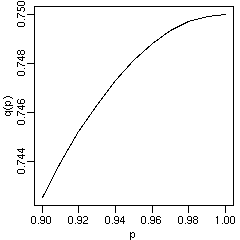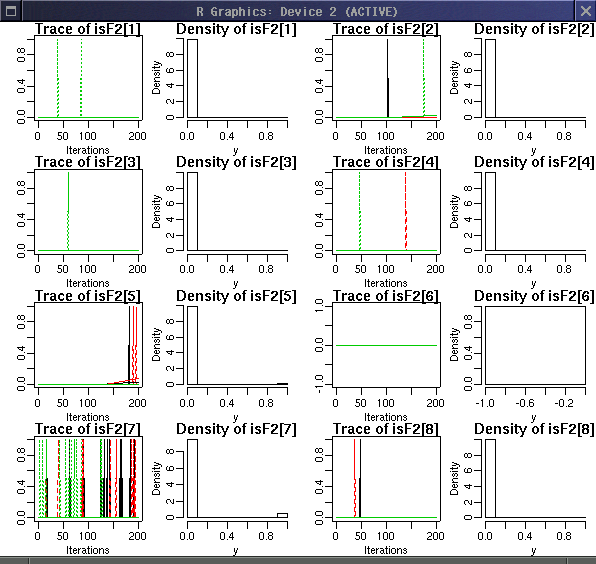
[F2 は遺伝子頻度の影響が少ない]
しかしいっしょに検討してると,
いろいろなことがわかった.
ある「種特異的」対立遺伝子がわりと高めの頻度 p で存在するときに,
F1 におけるその遺伝子のあり・なしは p の影響をもろにうけるけど,
F2 になると dominance の効果で応答性が鈍感になる,
とわかった.
Background: Herbivory can affect every aspect of a plant's life.
Damaged individuals may show
decreased survivorship and reproductive output.
Additionally, specific plant species (legumes) and
tissues (flowers) are often selectively targeted by herbivores, like deer.
These types of herbivory influence a plant's growth and abundance.
The objective of this study was to identify the effects of
leaf and meristem removal (simulated herbivory within an exclosure) on fruit and flower
production in four species (Rhus glabra, Rosa arkansana, Lathyrus venosus, and
Phlox pilosa) which are known targets of deer herbivory.
Results: Lathyrus never flowered or went to seed, so we were unable to detect any
treatment effects. Leaf removal did not affect flower number in the other three
species. However, Phlox, Rosa, and Rhus all showed significant negative correlations
between seed mass and leaf removal. Meristem removal had a more negative effect than
leaf removal on flower number in Plhilox and on both flower number and seed mass in Rosa.
Conclusions: Meristem removal caused a greater response than defoliation alone in both
Phlox and Rosa, which suggests that meristem loss has greater effect on reproduction.
The comibation of leaf and meristem removal as well as recruitment limitaion by deer,
which selevtively browse for these species, is likely to be one factor contributing
to their abundance in prairies.
(abstract)
Source strength (assimilate supply) and sink strength
(assimilate demand) of the plant were varied in different
ways to investigate to what extent flower/fruit abortion
in sweet pepper (Capsicum annuum L.) is determined by
the availability of assimilates. Source strength was
varied by changing the light level, plant density, and
leaf pruning. Sink strength was varied by changing the
temperature and the number and position of earlier
formed fruits. Shading as well as heating for short
periods showed that when source strength decreased,
the rate of abortion increased linearly, whether source
strength was decreased by shading, high plant density,
or leaf pruning. That flower and fuit abortion not only
depends on the source strength but also on the sink
strength of competing organs is shown by varying the
number or the position of earlier formed fruits. With the
same source strength, the rate of abortion showed
a close relationship with the growth rate of the earlier
formed competing fruits, suggesting that the induction
of abortion by earlier formed fruits is due to their sink
strength. Most of the variation in abortion could be
related to differences in vegetative growth rate, the latter
being an indicator or the source-sink ratio. However,
with the same vegetative growth rate, the rate of abortion
was lower for the leaf pruning treatments where no
competing fruits were retained than for the fruit load
treatments. This indicates that although most of the
variation in abortion can be related to the source and
sink strength of the plant, some effects of competing
fruits can only be explained by a combination of competition
and dominance.
1. Clonal integration in plants can improve their ability to cope with heterogeneity.
Integration may increase in response to damage, such as herbivore attack, if
undamaged ramets support damaged ones. To test this, we studied the effect of apex
removal and substantial defoliation on the perfomance of the clonal perennial herb
Linaria vulgaris Mill. in a common-garden growth experiment and 13C-labeling
study.
2. In the growth experiment, contrary to expectations, the target ramet could compensate
for damage better wht the other ramets in the clone were also damaged, indicating
within-clone competition for resource rather than support to damaged ramets.
3. In the 13C-labeling experiment, 5-7% of the lable moved to a neighbor ramet
in controls. Apex removal resulted in a negative net translocation of 13C in
the damged ramet, but defoliation led to zero net translocation.
4. The observed lack of support to damaged ramets in Linaria suggests that plasticity
of clonal integration in this species includes competition between sibling ramets.
Although young ramets may be supported, resources are not directed towards a single
damaged ramet if there are more viable intact ramets in the clone. Our main results
are consistent with the notion that resource allocation among ramets depends on their
relative value in term so fexpected fitness profits in heterogeneous environments.
To clarify the ecophsiological characteristics of plants growing on a coastal dune,
net photosynthetic rate (Pn) and leaf conductance (g1) of three perennial species in
Japanese coastal regions, ...
were compared under controlled environmental conditions and field
conditions at the Kado-ori coast at Ohno Village, Ibaraki. I.anthepheroides achived
photosynthetic CO2 saturation at ca. 100 μl-1 intercellular CO2 concentration (C1),
andits Pn was not light-saturated at a high photosynthetically active photon flux density
(PPFD) of 1000 μmol m-2 s-1. This C4 species showed a high optimal leaf temperature
for Pn (35°C) and a low g1 (0.1 mol H20 m-2 s-1), permitting maintenance of the
highest water use efficiency (WUE, the ratio of Pn to transpirationrate (Tr)) in the field
among the three species.
...
...

# N.sample 個体の遺伝子データ,遺伝子座数は N.loci
# 個体 i の遺伝子座 X[i, j] は 0, 1 のデータをとる (AFLP データ)
# 個体 i が F1 であるとき isF2[i] <- 0,
# F2 であるとき isF2 <- 1 (unknown)
# 遺伝子座 j における種特異的対立遺伝子の存在確率は p[j] (unknown)
model
{
# F1 vs. F2 アサインメント
for (i in 1:N.samples) {
isF2[i] ~ dbern(0.5) # 0, 1: 無情報事前分布
type[i] <- isF2[i] + 1 # 1, 2
for (j in 1:N.loci) {
X[i, j] ~ dbern(prob[type[i], j])
}
}
# 種特異的遺伝子の頻度
for (j in 1:N.loci) {
p[j] ~ dunif(0, 1) # 無情報事前分布
prob[1, j] <- p[j]
prob[2, j] <- 1 - (
p[j] * p[j] / 4 + p[j] * (1 - p[j]) / 2
+ (1 - p[j]) * (1 - p[j])
)
}
}
isF2[i]
の事後分布.
0 と 1 のあいだをいったりきたりしてる.

p[j]
の事後分布.
